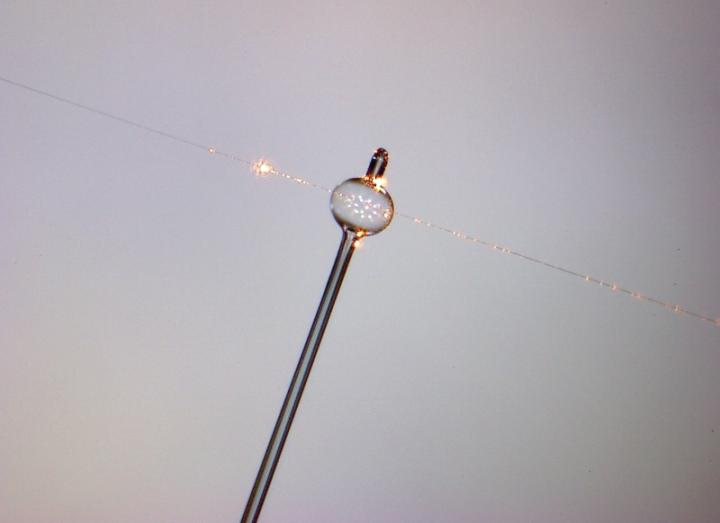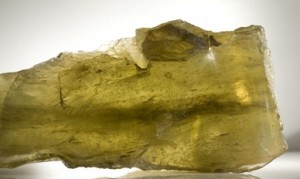
Caption: A magnified photograph of a glass Whispering Gallery Resonator. The bubble is extremely small, less than the width of a human hair. Credit: OIST (Okinawa Institute of Science and Technology Graduate University)
It was the reference to a whispering gallery which attracted my attention; a July 11, 2018 news item on Nanowerk is where I found it,
Technology created by researchers at the Okinawa Institute of Science and Technology Graduate University (OIST) [Japan] is literally shedding light on some of the smallest particles to detect their presence – and it’s made from tiny glass bubbles.
The technology has its roots in a peculiar physical phenomenon known as the “whispering gallery,” described by physicist Lord Rayleigh (John William Strutt) in 1878 and named after an acoustic effect inside the dome of St Paul’s Cathedral in London. Whispers made at one side of the circular gallery could be heard clearly at the opposite side. It happens because sound waves travel along the walls of the dome to the other side, and this effect can be replicated by light in a tiny glass sphere just a hair’s breadth wide called a Whispering Gallery Resonator (WGR).
A July 11, 2018 OIST press release by Andrew Scott (also on EurekAlert), provides more details,
When light is shined into the sphere, it bounces around and around the inner surface, creating an optical carousel. Photons bouncing along the interior of the tiny sphere can end up travelling for long distances, sometimes as far as 100 meters. But each time a photon bounces off the sphere’s surface, a small amount of light escapes. This leaking light creates a sort of aura around the sphere, known as an evanescent light field. When nanoparticles come within range of this field, they distort its wavelength, effectively changing its color. Monitoring these color changes allows scientists to use the WGRs as a sensor; previous research groups have used them to detect individual virus particles in solution, for example. But at OIST’s Light-Matter Interactions Unit, scientists saw they could improve on previous work and create even more sensitive designs. The study is published in Optica.
Today, Dr. Jonathan Ward is using WGRs to detect minute particles more efficiently than ever before. The WGRs they have made are hollow glass bubbles rather than balls, explains Dr. Ward. “We heated a small glass tube with a laser and had air blown down it – it’s a lot like traditional glass blowing”. Blowing the air down the heated glass tube creates a spherical chamber that can support the sensitive light field. The most noticeable difference between a blown glass ornament and these precision instruments is the scale: the glass bubbles can be as small as 100 microns- a fraction of a millimeter in width. Their size makes them fragile to handle, but also malleable.
Working from theoretical models, Dr. Ward showed that they could increase the size of the light field by using a thin spherical shell (a bubble, in other words) instead of a solid sphere. A bigger field would increase the range in which particles can be detected, increasing the efficacy of the sensor. “We knew we had the techniques and the materials to fabricate the resonator”, said Dr. Ward. “Next we had to demonstrate that it could outperform the current types used for particle detection”.
To prove their concept, the team came up with a relatively simple test. The new bubble design was filled with a liquid solution containing tiny particles of polystyrene, and light was shined along a glass filament to generate a light field in its liquid interior. As particles passed within range of the light field, they produced noticeable shifts in the wavelength that were much more pronounced than those seen with a standard spherical WGR.
With a more effective tool now at their disposal, the next challenge for the team is to find applications for it. Learning what changes different materials make to the light field would allow Dr Ward to identify and target them, and even control their activity.
Despite their fragility, these new versions of WGRs are easy to manufacture and can be safely transported in custom made cases. That means these sensors could be used in a wide verity of fields, such as testing for toxic molecules in water to detect pollution, or detecting blood borne viruses in extremely rural areas where healthcare may be limited.
For Dr. Ward however, there’s always room from improvement: “We’re always pushing to get even more sensitivity and find the smallest particle this sensor can detect. We want to push our detection to the physical limits.”
Here’s a link to and a citation for the paper,
Nanoparticle sensing beyond evanescent field interaction with a quasi-droplet microcavity by Jonathan M. Ward, Yong Yang, Fuchuan Lei, Xiao-Chong Yu, Yun-Feng Xiao, and Síle Nic Chormaic. Optica Vol. 5, Issue 6, pp. 674-677 (2018) https://doi.org/10.1364/OPTICA.5.000674
This paper is open access.
